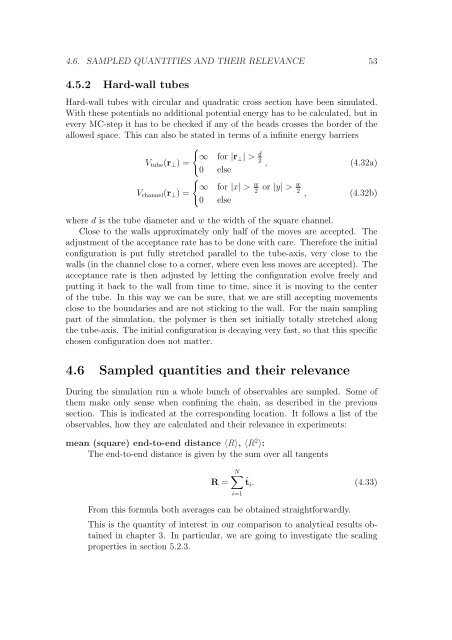Polymers in Confined Geometry.pdf
Polymers in Confined Geometry.pdf
Polymers in Confined Geometry.pdf
You also want an ePaper? Increase the reach of your titles
YUMPU automatically turns print PDFs into web optimized ePapers that Google loves.
4.6. SAMPLED QUANTITIES AND THEIR RELEVANCE 53<br />
4.5.2 Hard-wall tubes<br />
Hard-wall tubes with circular and quadratic cross section have been simulated.<br />
With these potentials no additional potential energy has to be calculated, but <strong>in</strong><br />
every MC-step it has to be checked if any of the beads crosses the border of the<br />
allowed space. This can also be stated <strong>in</strong> terms of a <strong>in</strong>f<strong>in</strong>ite energy barriers<br />
<br />
∞ for |r⊥| ><br />
Vtube(r⊥) =<br />
d<br />
2 , (4.32a)<br />
Vchannel(r⊥) =<br />
0 else<br />
<br />
∞ for |x| > w<br />
2<br />
0 else<br />
or |y| > w<br />
2<br />
, (4.32b)<br />
where d is the tube diameter and w the width of the square channel.<br />
Close to the walls approximately only half of the moves are accepted. The<br />
adjustment of the acceptance rate has to be done with care. Therefore the <strong>in</strong>itial<br />
configuration is put fully stretched parallel to the tube-axis, very close to the<br />
walls (<strong>in</strong> the channel close to a corner, where even less moves are accepted). The<br />
acceptance rate is then adjusted by lett<strong>in</strong>g the configuration evolve freely and<br />
putt<strong>in</strong>g it back to the wall from time to time, s<strong>in</strong>ce it is mov<strong>in</strong>g to the center<br />
of the tube. In this way we can be sure, that we are still accept<strong>in</strong>g movements<br />
close to the boundaries and are not stick<strong>in</strong>g to the wall. For the ma<strong>in</strong> sampl<strong>in</strong>g<br />
part of the simulation, the polymer is then set <strong>in</strong>itially totally stretched along<br />
the tube-axis. The <strong>in</strong>itial configuration is decay<strong>in</strong>g very fast, so that this specific<br />
chosen configuration does not matter.<br />
4.6 Sampled quantities and their relevance<br />
Dur<strong>in</strong>g the simulation run a whole bunch of observables are sampled. Some of<br />
them make only sense when conf<strong>in</strong><strong>in</strong>g the cha<strong>in</strong>, as described <strong>in</strong> the previous<br />
section. This is <strong>in</strong>dicated at the correspond<strong>in</strong>g location. It follows a list of the<br />
observables, how they are calculated and their relevance <strong>in</strong> experiments:<br />
mean (square) end-to-end distance 〈R〉, 〈R 2 〉:<br />
The end-to-end distance is given by the sum over all tangents<br />
R =<br />
N<br />
ˆti. (4.33)<br />
From this formula both averages can be obta<strong>in</strong>ed straightforwardly.<br />
i=1<br />
This is the quantity of <strong>in</strong>terest <strong>in</strong> our comparison to analytical results obta<strong>in</strong>ed<br />
<strong>in</strong> chapter 3. In particular, we are go<strong>in</strong>g to <strong>in</strong>vestigate the scal<strong>in</strong>g<br />
properties <strong>in</strong> section 5.2.3.













